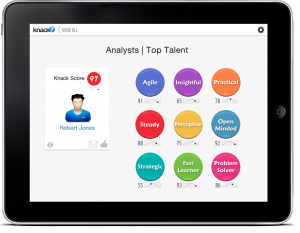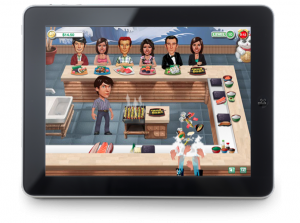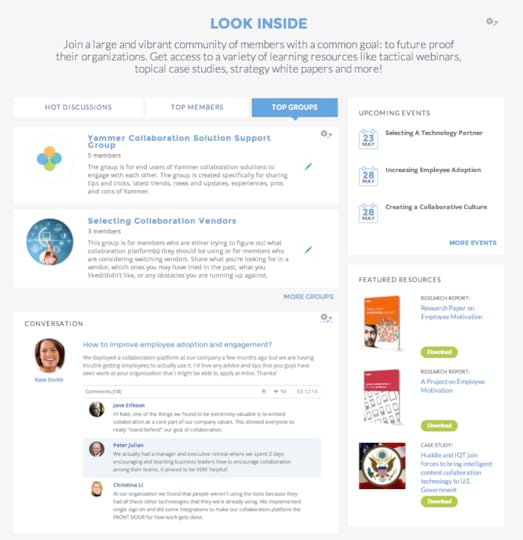Jacob Morgan's Blog, page 33
June 5, 2014
The Future of Work and Millennials from SAP’s SAPPHIRE Conference (Video)
This past week I was in Orlando, Florida for SAP’s annual SAPPHIRE conference where I keynoted a session on the future of work and participated in a few panel discussions and videos. I will share all of those here in due time but for now I wanted to share a short 2 minute clip in which I share some personal information about me and how I ended up in this particular field. I also talk a bit about millennials and the changing dynamic we are seeing in the workplace today.
 Send to Kindle
Send to KindleThe post The Future of Work and Millennials from SAP’s SAPPHIRE Conference (Video) appeared first on The Future Workplace.





June 1, 2014
Heading to Orlando for SAP’s SAPPHIRE Conference
Tomorrow I’m heading off to Orlando for two nights where I will be speaking at Sapphire and where SAP will debuting a short 3 minute video we worked on together all around the future of work (I saw a sneak peak and it’s awesome!). I’ll be arriving Monday evening and departing Wednesday morning so it’s a pretty quick trip, however if you are in Orlando for the event let me know and perhaps we can at least say hello!
Here’s my speaking schedule:
10:30 am-11:15 am: Keynote on the future of work in the Forum Theater
12:30 pm – 1:30 pm: Analyst panel on the future of work in Multiplex- Room C
2:30 pm – 2:50 pm : Moderating a panel on millennials in the workplace the Forum Theater
Aside from these speaking spots I’ll be participating in a radio show, short video interview, and a few other events. If you get a chance to attend any of the sessions that I’m taking part of then we can always chat for a few minutes afterwards as well. I’m very excited to be speaking and attending and I hope to meet a lot of new people! The big theme I’m going to be exploring in all of my sessions is “challenging convention,” I’m sure this will lead to some interesting discussions and debates.
See you in Orlando!
 Send to Kindle
Send to KindleThe post Heading to Orlando for SAP’s SAPPHIRE Conference appeared first on The Future Workplace.





May 28, 2014
Driving Culture Change Ain’t So Easy!
Yesterday SAP invited me to join their radio program called “Game Changers” to talk about transforming corporate culture within organizations. We talked about collaboration, millennials, the future of work, and a whole bunch of other things.
I joined Sarah Cooke, associate vice president from Great Place to Work and Deb Stambaugh, the senior director of talent marketing from SAP. We had an hour long chat about culture and the future of work and it’s one of the more up-beat and fun radio appearances I’ve done. Here’s the show description:
“The buzz: Culture. How do you start your business day? Peter Drucker says, “Culture eats strategy for breakfast.” Increasingly, companies today see workplace culture as fundamental to success. But if your organization’s culture is not serving your business goals, changing it and getting your employees to embrace the change can be a daunting uphill challenge. Would you like to know what works and doesn’t work for companies that have successfully climbed this steep slope? The experts speak. Jacob Morgan, Chess Media Group: “”Work as we know it is dead”. Sarah Cooke, Great Place to Work: “In most organizational change efforts, it is much easier to draw on the strengths of the culture than to overcome the constraints by changing the culture” (Prof. Edgar Schein, MIT Sloan School of Management). Deb Stambaugh, SAP: ““If you get the culture right, most of the other stuff will just take care of itself” (Tony Hsieh, CEO of Zappos). Join us for Driving Culture Change: Easier Said Than Done.”
If you have some time, take a listen, it’s a fun show!
 Send to Kindle
Send to KindleThe post Driving Culture Change Ain’t So Easy! appeared first on The Future Workplace.





May 23, 2014
Long Term Employment? You Must Be Joking!
 A few decades ago there was an implicit contract between employees and the organizations they worked for. As an employee, you would be loyal and committed to the organization you worked for – giving it your labor and your attention. In exchange that organization would take care of you for life. In fact, working at an organization for 20, 30, or over 40 years was really not that uncommon. Then, once you would leave that organization you would get a pension. Some of these long-term employees still exist but they are a rare dying breed on the verge or retirement (or have reached a point where they too now need to switch jobs). Contrast that with people like my 22 year brother who doesn’t even know what a pension is, and neither to most other people his age.
A few decades ago there was an implicit contract between employees and the organizations they worked for. As an employee, you would be loyal and committed to the organization you worked for – giving it your labor and your attention. In exchange that organization would take care of you for life. In fact, working at an organization for 20, 30, or over 40 years was really not that uncommon. Then, once you would leave that organization you would get a pension. Some of these long-term employees still exist but they are a rare dying breed on the verge or retirement (or have reached a point where they too now need to switch jobs). Contrast that with people like my 22 year brother who doesn’t even know what a pension is, and neither to most other people his age.
Long term or life-time employment as we know it today is completely, utterly, and unequivocally, 120% dead, and it ain’t coming back…ever.
The latest numbers from the bureau of labor statistics show that the average tenure was 4.6 years based on data released in January 2012. For workers over 65 the average tenure was 10.3 years and for workers between 25-34 the average tenure was 3.2 years. If you combine this data with the fact that large organizations are more rapidly getting replaced by other incumbents, then you have a bit of an “interesting” situation.
But why is this happening? There are a few reasons.
Globalization
Our access to opportunities is no longer limited to our physical location like it was decades ago. Today, you can be based in Beijing yet still have the opportunity to work for the hottest start-up in the Bay Area (which for many eventually means re-location). More opportunities and access to organizations all over the world means more choice, more freedom, and less commitment to one organization.
Big company doesn’t mean job security
I wrote about this a few weeks ago, but with the massive sweeping layoffs that many larger organizations go through, the incentive to work there shrinks dramatically. This means that the idea of seeing companies as “stepping stones” to better opportunities is pretty much the norm. The new workforce is growing up seeing these things happening first hand so they are very aware of this and preparing themselves accordingly.
Accelerating rate of change
Not only is the world of work changing but the rate at which it is changing is accelerating . This creates more market turbulence and instability. This heavily ties into the theme above about large organizations and job security. However, market turbulence affects all organizations and all industries. In more dynamic and turbulent conditions there is no such thing as long term stability. People get tossed around from place to place, companies go under, new companies emerge, and this cycle happens increasingly more often.
New loyalties
Instead of being loyal to a particular company, many are now loyal to specific people they work with . When these people leave they usually bring their “friends” with them.
Changing expectations
Today the levels of employee disengagement appear to be staggeringly high. This means that new employees start out working for an organization with a very positive outlook. However, once they start to feel like they are not appreciated, not enjoying their jobs, etc. They start to look elsewhere. Consider the many opportunities that are now present through crowd-funding sites like Indiegogo, disrupting businesses like Uber or Lyft, the ease of starting your own business, or even becoming a full-time freelancer on sites like oDesk or Elance. The mind-set of lifetime or long-term employment doesn’t even exist for many employees today. They simply expect to be at an organization for a few years and then move onto the next thing.
So, now that we know that long-term employment is dead, what should organizations be doing to adapt? This is a topic that I’m going to explore in my next post. In the meantime I’d love to hear your thoughts, experiences, and feedback around this. Are you noticing this trend at your organization and if so, what are you doing about it?
 Send to Kindle
Send to KindleThe post Long Term Employment? You Must Be Joking! appeared first on The Future Workplace.





May 14, 2014
The White House Releases Their United States Open Data Action Plan
The White House just released their Open Data Action Plan which is worth taking a look at if you have a few minutes. It’s the Government’s approach to treating data and information as a national asset which means opening up it’s data whenever possible. We have seen this in action with data.gov which allows visitors to explore data on everything from agriculture to weather.
Opening up data and information is being seen as a way to further help fuel innovation while tapping into the collective intelligence of citizens to be able to solve problems. Clearly the Government won’t be sharing all of their data but what they are sharing is rather extensive. The meat of the Open Data Action Plan are the four commitments that The White House has made.
Publish open data in a discoverable, machine-readable, usable way
Data.gov is an example of what this looks like. The goal is for The White House to not only provide the data but to make it easy for users to manipulate and extract insights from the data that it provides.
Work with the public and civil society organizations to prioritize open data sets for release
New data sets are going to be prioritized and shared based on public feedback. Think of it like a global voting system. Obviously the government has tons of data that it collects so this provides a method of sorting.
Support innovators and improve open data based on feedback
This will be done in several ways which include: in-person and online events such as idea jams, offering open source tools to help users share and improve open data, hosting feedback sessions, and launching incentives and challenges to use open data to solve problems and meet policy goals.
Continue to release and enhance high-priority data sets
The U.S. Government is going to rely on what it calls Presidential Innovation Fellows that will all work on various data innovation projects. These fellows will team up with various government agencies for 6-12 months. These agencies include NASA, The U.S. Department of Interior, The U.S. Department of Energy, The IRS, and many others. Each agency is faced with a particular set of challenges around opening up their data which is where the Innovation Fellows will help.
It’s a great and important sign to see the U.S. commit to open data. By giving more people access to data the amount of problems that can be solved and complexity of the problems that can be solved increased dramatically. It’s akin to managers tapping into the collective intelligence of their employees for decision making but taking that concept and applying it at a much broader scale.
My Linkedin article, “The Number One Thing That All Employees Should Be Doing At Work: Building Weak Ties” talks about that in more detail.
It will be very interesting to see where this leads in the next few years, not just in the United States, but around the world.
 Send to Kindle
Send to KindleThe post The White House Releases Their United States Open Data Action Plan appeared first on The Future Workplace.





May 8, 2014
Introducing the FOW Community; Dedicated to the Future of Work and Collaboration
For well over the past year my team and I at Chess Media Group have been working on a huge project, the FOW Community. It’s a “by invitation only” membership community dedicated to the future of work and collaboration. This is something we thought of doing a few years ago but it did not materialize until last year. Over the past few years we have worked with, researched, and spoken with several hundred organizations of all shapes and sizes globally. We learned that when it comes to the future of work and collaboration, there are a few common needs that organizations have:
Organizations want to connect with other organizations to learn what they are doing, share best practices, and build a valuable peer network.
Organizations want to be able to access regular resources on the future of work and collaboration, such as case studies, research, strategy white papers, and other related content (and they want to have a say in the topics covered in these resources – topics that are relevant to their needs!)
Organizations want access to an objective and credible third party strategy firm that has actually worked with many types of organizations to help make their future of work and collaboration initiatives successful.
Organizations want to have all of this available to them in one place and they want it to be easy!
These reasons are exactly why we created the FOW Community. Truth be told, we explored all sorts of options for how we could do this, including leveraging existing out-the-box community platforms. In the end, we decided to build a platform ourselves from scratch. We did this for a few reasons. The first is that we wanted to remain vendor neutral. The second is that for this type of a cross-industry and cross-organizational community there are specific features and requirements which many existing platforms don’t meet, after all, most collaboration platforms were designed to be deployed within a single company, not across many. Finally, we wanted the members to be able to shape the community itself, down to the very features and functionality that the community provides.
We understand that there are plenty of free groups and communities online via places like Facebook, LinkedIn, Google+, and other free platforms. Of course, you are more than welcome to be a part of those communities. However, we found a few issues with those communities, as did the organizations we spoke with:
Most of the people who are a part of those communities are vendors or consultants.
The free communities act as nothing more than forums or discussions boards; they aren’t really robust platforms designed to help organizations solve tough challenges internally.
The conversations are oftentimes not private and secure and the platforms themselves look and feel quite outdated.
Free communities are very limited in the features that they offer.
The quality of the conversations are neither that deep, nor are they very broad.
Members have no control over the functionality of the platform. What you see is what you get.
And a few other issues, but I don’t need to list them all.
This isn’t to say that free communities are bad. In fact, I’d much rather see you in a free community than no community at all. However, to do what we are trying to do and to achieve our long-term vision, we knew we had to build it ourselves, and build we did (and it looks beautiful!)
The FOW Community is going launch to the public within a few weeks. We already have some great companies and “founding members” who are going to help kick this off. If you want to request an invitation to join them, then you can do so on our landing page.
Along with the membership community we will be launching a robust, public-facing site with lots of great educational content and information, this will be unveiled in a few weeks.
Here’s a very early sneak peak of what we are creating. This screenshot is from the public facing site we are launching, which will also provide a “look-inside” to the FOW Community so people can get a sense of what they are joining.
This is the very first step towards a big vision we have for the future of work and collaboration. We hope that you will join us for what is sure to be a very fun and exciting new journey!
Request your invite the FOW Community.
 Send to Kindle
Send to KindleThe post Introducing the FOW Community; Dedicated to the Future of Work and Collaboration appeared first on The Future Workplace.





May 6, 2014
People Analytics; Coming to a Workplace Near You!
 Imagine you’re going in for a job interview. You put on a nice suit, polish your shoes, print out a copy of your resume which lists your many accomplishments and head out the door. You even arrive at the office thirty minutes before your interview just to help make a good impression, you really want this job! After a few minutes of you hanging out in the lobby someone comes to greet you and take you into her office. You both sit down and she offers you something to drink, “no thanks,” you say, “I’m really excited to be meeting with you and think that my background, accomplishments, and personal attributes will make me a real asset here.” Before you have time to explain she takes out a tablet device and says, “that’s great to hear, before we do anything I want you to play a few games, I’ll be back in around forty-five minutes.” One game sees you as a waiter in a restaurant serving food to guests who come in and another game sees you launching balloons at little demons who are trying to attack you. You finish playing both games and the lady walks back in and says, “congratulations, you’re hired.” You just had your job interview playing a game that told the company everything they needed to know about you.
Imagine you’re going in for a job interview. You put on a nice suit, polish your shoes, print out a copy of your resume which lists your many accomplishments and head out the door. You even arrive at the office thirty minutes before your interview just to help make a good impression, you really want this job! After a few minutes of you hanging out in the lobby someone comes to greet you and take you into her office. You both sit down and she offers you something to drink, “no thanks,” you say, “I’m really excited to be meeting with you and think that my background, accomplishments, and personal attributes will make me a real asset here.” Before you have time to explain she takes out a tablet device and says, “that’s great to hear, before we do anything I want you to play a few games, I’ll be back in around forty-five minutes.” One game sees you as a waiter in a restaurant serving food to guests who come in and another game sees you launching balloons at little demons who are trying to attack you. You finish playing both games and the lady walks back in and says, “congratulations, you’re hired.” You just had your job interview playing a game that told the company everything they needed to know about you.
 Meet “Knack“, a new company in Silicon Valley which is changing the way that employers are looking at potential talent. In most job interviews the employer relies on a lot of superficial information like a piece of paper with accomplishments, how the candidate might answer a few questions, how they dress, what they look like, and how they speak. None of these things really give us much depth into the person we are hiring regardless of how clever you want to get with the interview questions. Companies like Knack are giving much greater insight into potential, behaviors, values, and qualities that a candidate might have. These types of games help match the right people with the right jobs.
Meet “Knack“, a new company in Silicon Valley which is changing the way that employers are looking at potential talent. In most job interviews the employer relies on a lot of superficial information like a piece of paper with accomplishments, how the candidate might answer a few questions, how they dress, what they look like, and how they speak. None of these things really give us much depth into the person we are hiring regardless of how clever you want to get with the interview questions. Companies like Knack are giving much greater insight into potential, behaviors, values, and qualities that a candidate might have. These types of games help match the right people with the right jobs.
According to the CEO of Knack, Guy Halfteck:
“Rapid structural shifts are changing the business, economic and demographic landscape and the distribution and availability of high-potential talent around the world.”
The team that designs the games at Knack is comprised of behavioral and data scientists, software and game developers, and game designers and artists. They look at hundreds of variables during game play such as how long you hesitate, what part of the screen you touch, the moves you make, and many other things. In fact they collect multiple pieces of data every mili-second. The result? A list of “Knacks” which are essentially the qualities that make you who you are. I recently played one of their games called “Wasabi Waiter” which had me identify the expressions of patrons as they entered my fictitious restaurant. My avatar had to provide menus, clean dishes, deliver food, and perform a series of tasks to keep the patrons happy and the food coming out. The games can tell you things such as if you are empathetic, risk averse, cool-headed, perceptive, a quick thinker, agreeable, an introvert/extrovert, and a host of other things. In fact the game probably knows the player better than the player knows themselves!
 Any organization would be able to leverage these games to hire people who possess the skills that are ideal for that role. For example if you were an executive at Morgan Stanley MS -2.02% would you want to hire an analyst who is prone to risk or risk averse? If you were running a restaurant would you want someone who was an introvert or an extrovert? If you were running a nuclear science facility would you want someone who is a thrill-seeker or someone who is not perceptive? The challenge today is that it’s not really possible to assess these things from just a few conversations during a job interview. Oftentimes we see two types of errors occurring. Either organizations turn down people who were actually a great fit for the job, or employees are hired who turn out to be a poor fit. What if these types of things could be minimized?
Any organization would be able to leverage these games to hire people who possess the skills that are ideal for that role. For example if you were an executive at Morgan Stanley MS -2.02% would you want to hire an analyst who is prone to risk or risk averse? If you were running a restaurant would you want someone who was an introvert or an extrovert? If you were running a nuclear science facility would you want someone who is a thrill-seeker or someone who is not perceptive? The challenge today is that it’s not really possible to assess these things from just a few conversations during a job interview. Oftentimes we see two types of errors occurring. Either organizations turn down people who were actually a great fit for the job, or employees are hired who turn out to be a poor fit. What if these types of things could be minimized?
We still have a long way to go before these types of games becoming widely used and adopted within organizations but it gives us a sneak peak of the direction that we might be headed. Some companies are already experimenting with these new approaches. The idea of games in the interview process also brings up a host of questions such as: What happens if you don’t have scores for any of the knacks, will you get rejected by the company? Will this completely take out the human component of interviews in the future? How accurate can the data be? Are there issues here around privacy? Will it be possible to “game the games?” All of these issues and I’m sure plenty more, will need to be addressed for many people and companies before this becomes a standard but based on my conversations with Guy, their CEO, it seems like they are thinking through all of these things.
These is also still something to be said for the human interaction and the “vibe” we get from someone when we meet them. Relying solely on games to help companies select candidates is still premature yet evolving. But imagine combining the interview process of meeting and speaking with someone with the information that a game like “Wasabi Waiter” can reveal. Now all of a sudden you have a very powerful combination.
There are all sorts of possibilities for where this can go. Everyone who uses Knack will have a unique Knack footprint. People can display their knacks, follow business leaders that have certain knacks, connect with other people who share the same knacks, and figure out what they have a knack for—at work, at school and beyond. These games are also just begging for a social networking component such as a tie in to Facebook, Linkedin, and Twitter that allows people to share and showcase their knacks.
Knack is still in the early stages with a big vision but the potential for something great and game changing is certainly there.
 Send to Kindle
Send to Kindle




April 14, 2014
Are You Removing Friction from Collaboration?
 When it comes to collaboration, friction is not a good thing either from a behavioral of from a technological standpoint. Imagine your collaboration effort is a equivalent to a skater gliding along the ice, every time you add a point of friction you basically make the gliding motion harder and harder to achieve until you get to a point where you’re trying to skate on concrete. Enough friction will kill even the best and most thought out collaboration initiatives. Here are some ideas to help remove or prevent friction from happening.
When it comes to collaboration, friction is not a good thing either from a behavioral of from a technological standpoint. Imagine your collaboration effort is a equivalent to a skater gliding along the ice, every time you add a point of friction you basically make the gliding motion harder and harder to achieve until you get to a point where you’re trying to skate on concrete. Enough friction will kill even the best and most thought out collaboration initiatives. Here are some ideas to help remove or prevent friction from happening.
Technology
Implement single sign on
Make sure the platform emulates common social experiences that people expect (i.e. Twitter, Facebook, etc)
Allow for easy integrations
Consider employee feedback in future feature roll-out
Make sure it’s easy to use and understand
Import profiles from Active Directory or other existing database
Implement suggestive features such as “people to follow,” “groups to join,” or “conversations to participate in”
Provide easy alerts and notifications when relevant
Allow employees to get access to daily or weekly email digests
Behavior
Provide educational resources and training along with community management
Make sure the physical and digital work environments both emulate and support each other
Understand use cases and pain points
Speak the language of the business
Focus on conveying individual value to employees instead of just corporate value to the organization
Make sure business and technical teams are both involved in the collaboration deployment
Have an internal marketing plan and make it fun
Reach out to the exemplars and the managers
I’m sure you can think of plenty of other things to add to this list but the point is that organization’s need to be thinking about how they can remove friction and not add it. Take a look at some of the rules, policies, or approaches that your organization is taking to collaboration and ask yourself if they are adding and removing friction. Do whatever you can to make sure that your collaboration efforts are as smooth as blades on ice, because nobody wants to or can skate on concrete.
 Send to Kindle
Send to Kindle




April 8, 2014
Collaboration and the Future of Work: Interview with Jacob Morgan
A few months ago I keynoted The Social Conference where I spoke about building a collaborative organization and what the future of work will look like. After my session I did a short video interview which you can find below. Flexible work was a hot topic of conversation at the event and there’s actually a great debate going on in the comments of my Linkedin post in this very topic.
Clearly, I needed a haircut (which I have since gotten) but aside from that, I hope you enjoy!
 Send to Kindle
Send to Kindle




April 3, 2014
Why You Should Give Up on Collaboration
We have no budget
Managers don’t support the project
It’s taking too long
It’s too complicated
I don’t have time time
We don’t have resources
Things are just fine the way they are
It’s on the “back burner”
Collaboration leaders and practitioners at companies all around the world have at some point thought these things. But these things didn’t stop companies like TELUS, Unisys, Wells Fargo, Safeway, and the many other organizations around the world who have been successful with their initiatives. So sure, you can stop, admit defeat, say you tried, and move onto the next thing. But while you’re doing that, think of the companies that are working harder, are more determined, and are more committed.
Over the next few years what do you think will happen at your company and what do you think will happen at theirs?
 Send to Kindle
Send to Kindle









